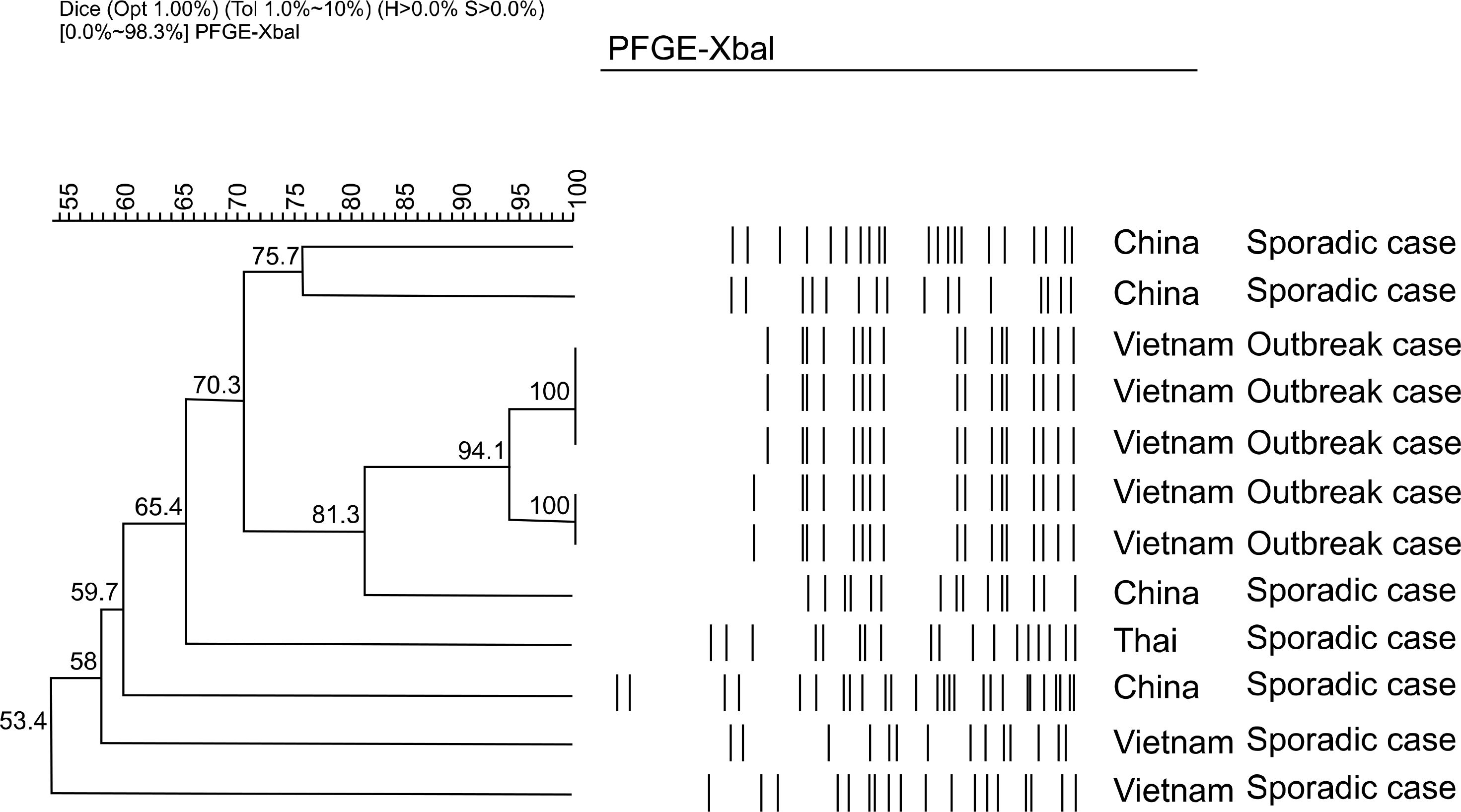Korean J Clin Microbiol.
2009 Dec;12(4):186-192.
Detection of the Causative Agents of Traveler's Diarrhea Using a Real-Time PCR Screening Method
- Affiliations
-
- 1Division of Enteric Bacterial Infections, National Institute of Health, Seoul, Korea. kkingsh@chol.com
- 2Gimhae National Quarantine Station, Gimhae, Korea.
Abstract
- BACKGROUND
The incidence of infectious diarrheal disease in Korea has decreased over the past decade, but traveler's diarrhea (TD) is increasing in frequency. We therefore investigated the distribution of the causative agents of TD.
METHODS
A total of 132 rectal swab specimens were acquired from TD patients who entered the country via Gimhae International Airport. The specimens were screened for 12 bacterial pathogens by real-time PCR, and target pathogens were isolated from the PCR positive specimens using conventional microbiological isolation methods.
RESULTS
A total of 93 specimens (70.5%) showed positive PCR screening results, and of these specimens, nine species and 50 isolates (37.9%), including Vibrio parahaemolyticus (18 isolates) and ETEC (17 isolates), were isolated. No specimens were PCR positive for Listeria monocytogenes or Campylobacter jejuni, and no pathogenic Bacillus cereus were isolated.
CONCLUSION
Even though viruses and EAEC were not included as target pathogens, the high isolation rate of these pathogens in this study provides indirect evidence that most cases of pathogen-negative TD are caused by undetected bacterial agents. Furthermore, our study results confirm the effectiveness of real-time PCR-based screening methods. This study is the first report in Korea to demonstrate that ETEC and V. parahaemolyticus are the major causative pathogens of TD, and this knowledge can be used to help treat and prevent TD.
Keyword
MeSH Terms
Figure
Reference
-
1. DuPont HL. Systematic review: the epidemiology and clinical features of travelers’ diarrhea. Alimen Pharmacol Ther. 2009; 30:187–96.2. Adachi JA, Jiang ZD, Mathewson JJ, Verenkar MP, Thompson S, Martinez-Sandoval F, et al. Enteroaggregative Escherichia coli as a major etiologic agent in traveler's diarrhea in 3 fegions of the world. Clin Infect Dis. 2001; 32:1706–9.3. Flores J, DuPont HL, Jiang ZD, Belkind-Gerson J, Mohamed JA, Carlin LG, et al. Enterotoxigenic Escherichia coli heat-labile toxin seroconversion in US travelers to Mexico. J Travel Med. 2008; 15:156–61.4. Meraz IM, Jiang ZD, Ericsson CD, Bourgeois AL, Steffen R, Taylor DN, et al. Enterotoxigenic Escherichia coli and diffusely adherent E coli as likely causes of a proportion of pathogen-negative travelers' diarrhea–a PCR-based study. J Travel Med. 2008; 15:412–8.5. Black RE. Epidemiology of travelers' diarrhea and relative importance of various pathogens. Rev Infect Dis. 1990; 12(Suppl 1):S73–9.
Article6. Steffen R, Collard F, Tornieporth N, Campbell-Forrester S, Ashley D, Thompson S, et al. Epidemiology, etiology, and impact of traveler's diarrhea in Jamaica. JAMA. 1999; 281:811–7.
Article7. Korea Centers for Disease Control and Prevention. Trends in imported cases of infectious diseases in Korea. Public Health Weekly Report. 2008; 1:633–7.8. Korea Centers for Disease Control and Prevention. Antigenic Formulas of the Salmonella Serovars. 2007.9. Lo̸vselth A, Loocareric S, Berdal KG. Modified multiplex PCR method for detection of pyrogenic exotoxin genes in Staphylococcal isolates. J Clin Microbiol. 2004; 42:3869–72.
Article10. Clinical and Laboratory Standards Institute. Performance standards for Antimicrobial Susceptibility Testing; Nineteenth Informational Supplement. Document M100-S19. Wayne, PA; CLSI,. 2009.11. Gutom RK. Rapid pulsed-field gel electrophoresis protocol for typing of Escherichia coli O157: H7 and other gram-negative organism in 1 day. J Clin Microbiol. 1997; 35:2977–80.12. Jiang ZD, Lowe B, Verenkar MP, Ashley D, Steffen R, Tornieporth N, et al. Prevalence of enteric pathogens among international travelers with diarrhea acquired in Kenya (Mombasa), India (Goa), of Jamaica (Montego Bay). J Infect Dis. 2002; 185:497–502.13. Korea Centers for Disease Control and Prevention. Diagnostic and reporting criteria for nationally notifiable communicable diseases. 2009.14. Iijima Y, Tanaka S, Miki K, Kanarmori S, Toyokawa M, Asari S. Evaluation of colony-based examinations of diarrheagenic Escherichia coli in stool specimens: low probability of detection because of low concentrations, particularly during the early stage of gastroenteritis. Diagn Microbiol Infect Dis. 2007; 58:303–8.15. Murray BE, Mathewson JJ, Dupont Hill WE. Utility of oligodeoxy-ribonucleotide probes for detection enterotoxigenic Escherichia coli. J Infect Dis. 1987; 155:809–11.16. Ko GP, Garcia C, Jiang ZD, Okhuysen PC, Belkind-Gerson J, Glass RI, et al. Noroviruses as a cause of travelers' diarrhea among students from the United States visiting Mexico. J Clin Microbiol. 2005; 43:6126–9.
Article17. Navaneethan U, Giannella RA. Mechanism of infectious diarrhea. Nat Clin Pract Gastroenterol Hepatol. 2008; 5:637–47.
- Full Text Links
- Actions
-
Cited
- CITED
-
- Close
- Share
- Similar articles
-
- Development of Molecular Diagnosis Using Multiplex Real-Time PCR and T4 Phage Internal Control to Simultaneously Detect Cryptosporidium parvum, Giardia lamblia, and Cyclospora cayetanensis from Human Stool Samples
- Outbreak of Cyclosporiasis in Korean Travelers Returning from Nepal
- Evaluation of a Newly Developed Multiplex Real-time PCR Assay for the Detection of Vancomycin-Resistant Enterococci from Rectal Swabs
- Causative agents and epidemiology of diarrhea in Korean native calves
- Risk of Water and Food-Borne Communicable Diseases in Travelers Entering Korea


